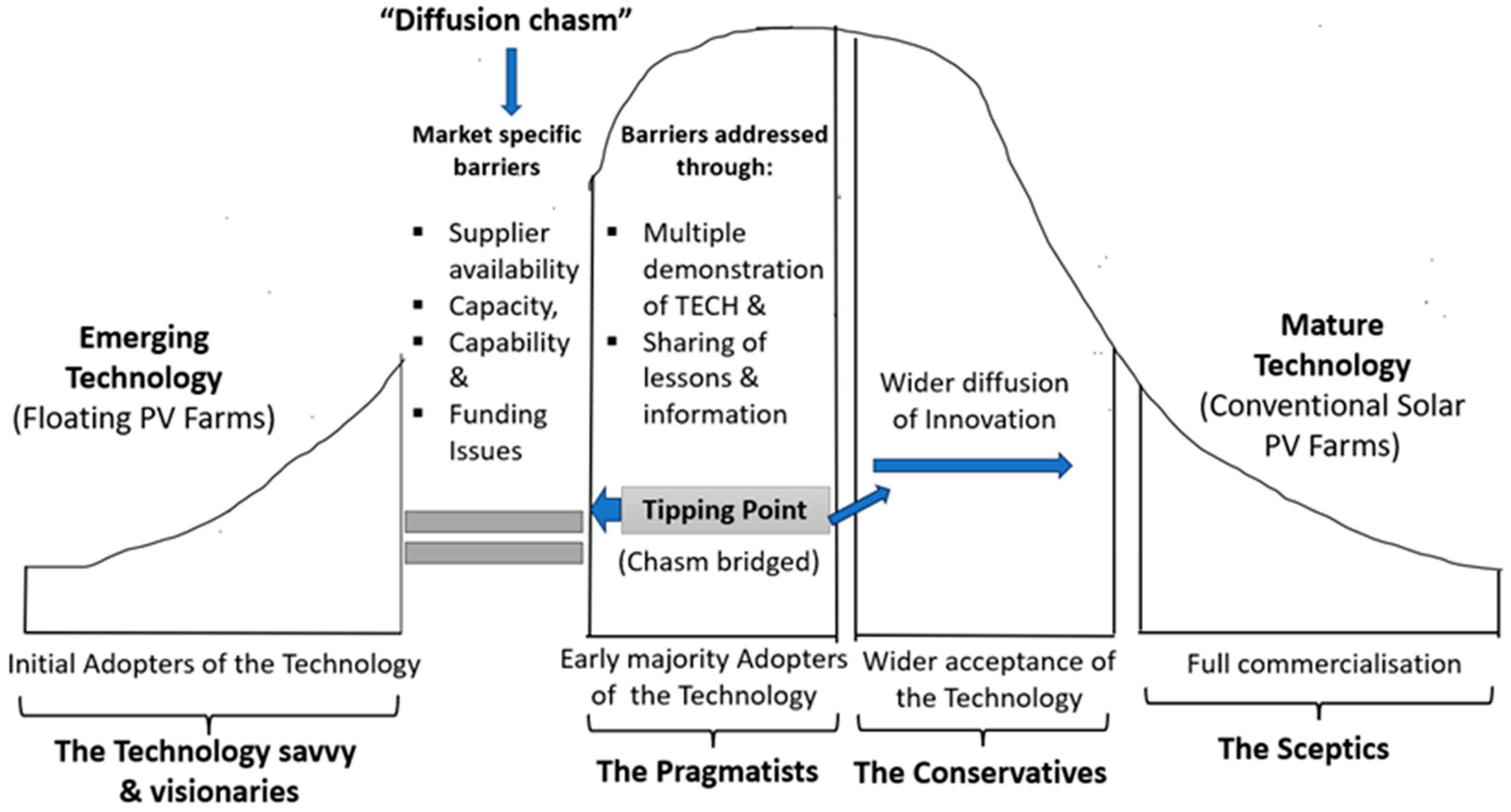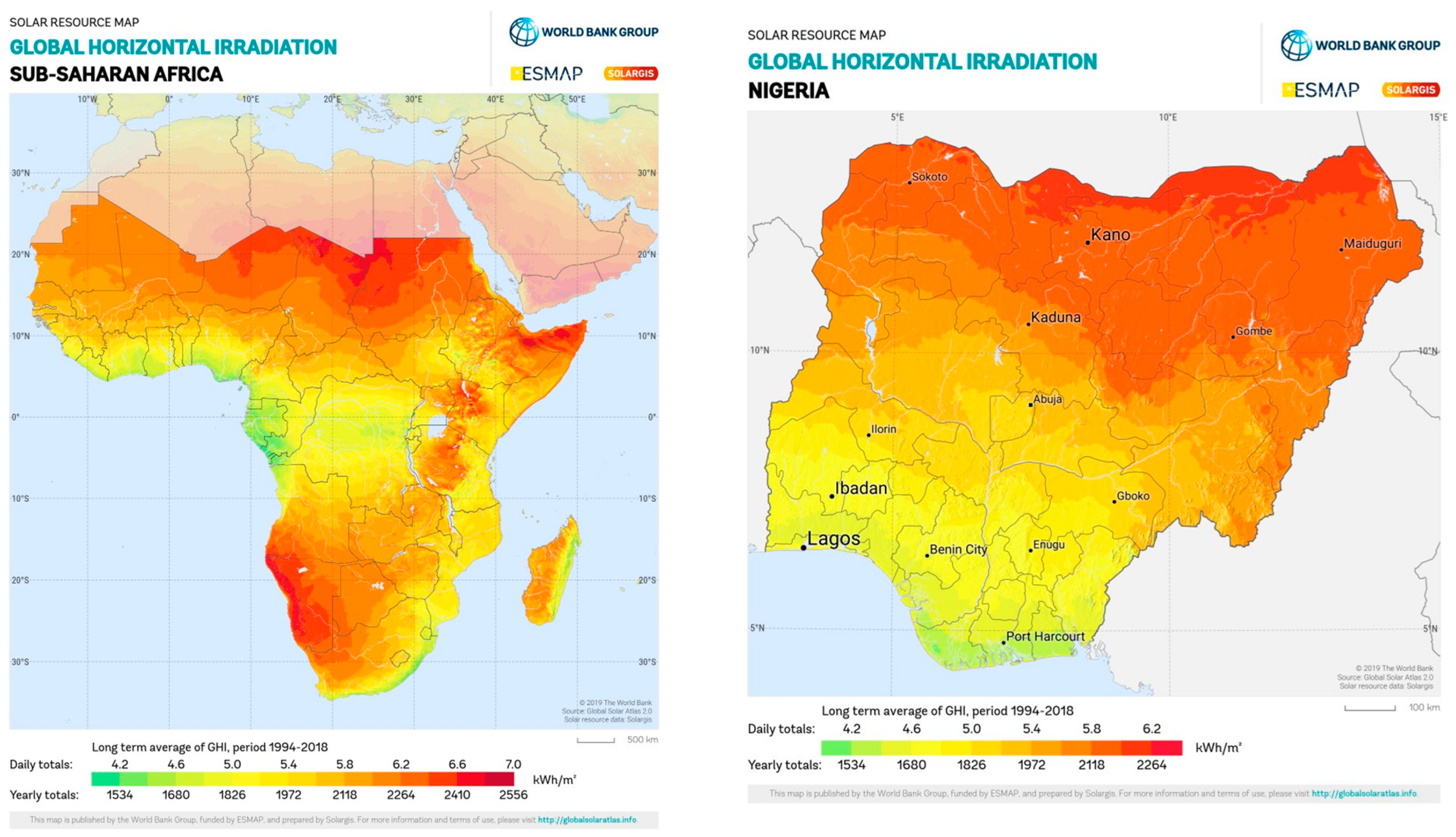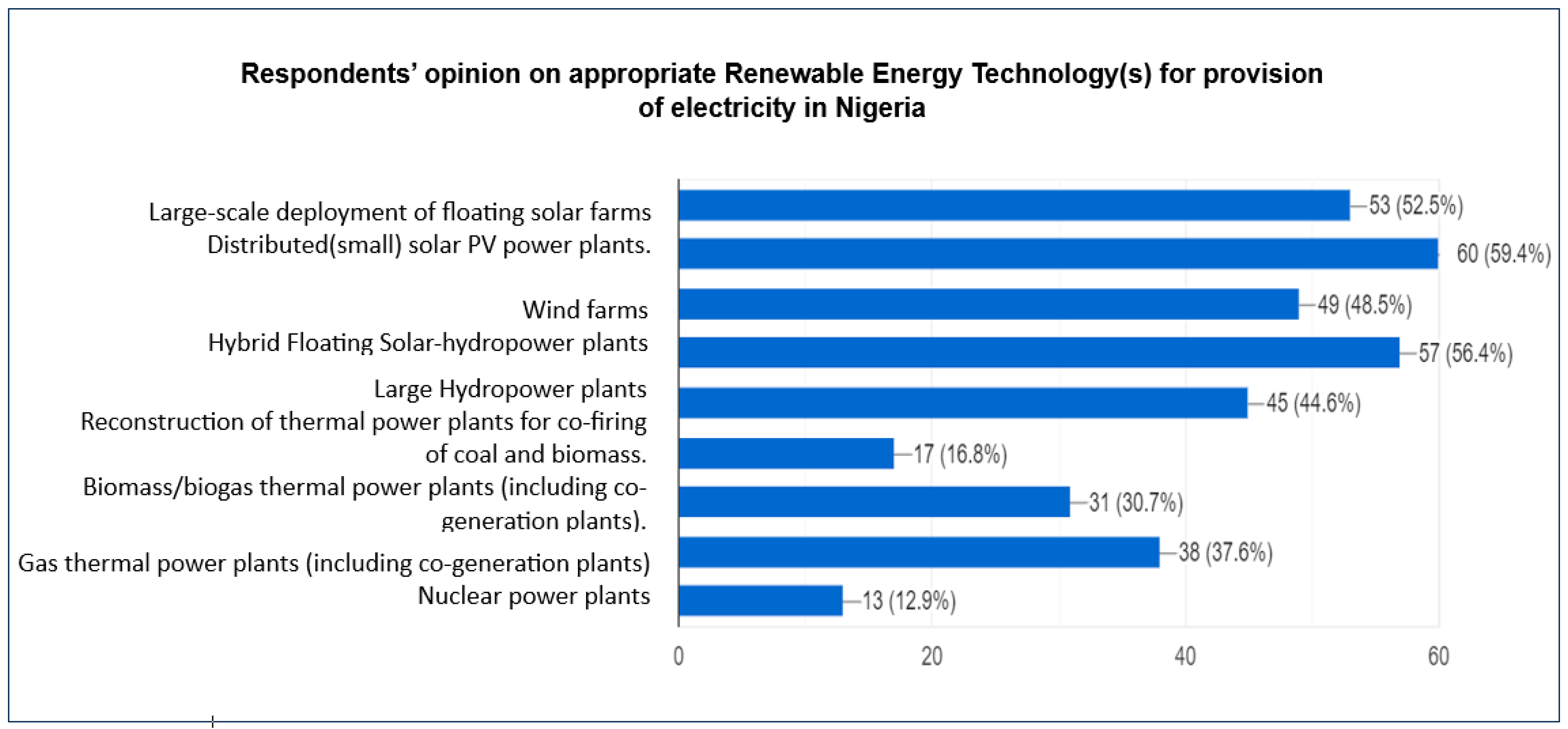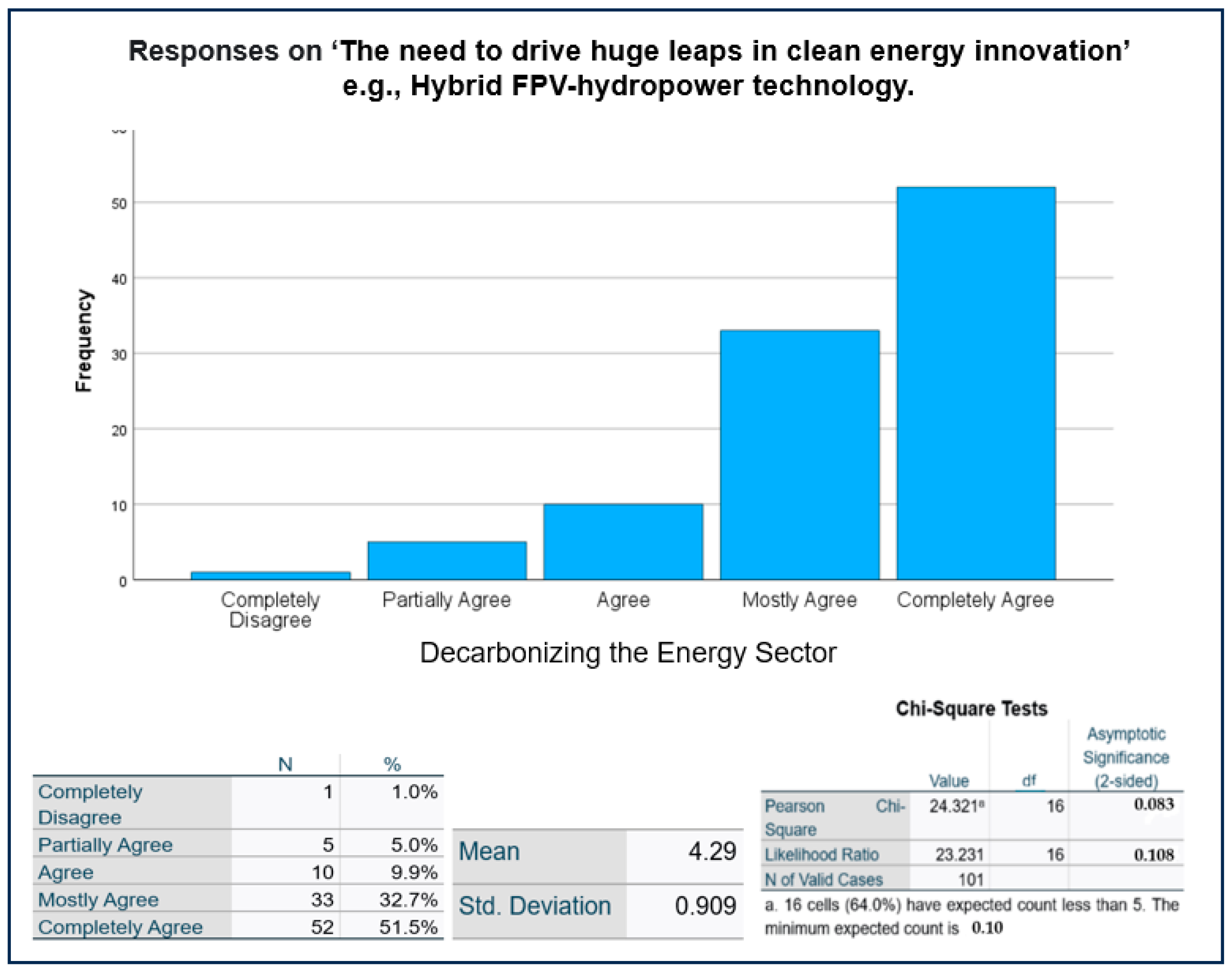Accelerating the Low-Carbon Energy Transition in Sub-Saharan Africa through Floating Photovoltaic Solar Farms
Abstract
1. Introduction
2. Methodology
3. Advancing Sub-Saharan Africa’s Energy Transition with Innovative Floating Solar Farms
4. Stakeholders’ Perspectives on Floating Solar Farms and Renewable Energy Adoption, and Decarbonization Strategies in Nigeria
Some Case Studies of FPV-HEPP Applications
5. Hybrid Floating Solar PV–Hydropower Systems: Advantages, Implementation Challenges, and Deployment Barriers in Sub-Saharan Africa
5.1. Advantages of Integrating Floating Solar Panels with Hydropower Systems
5.2. Challenges in Implementing FPV–Hydropower Systems
5.3. Barriers to Hybrid Floating Solar PV–Hydropower Technology Deployment in Sub-Saharan Africa
6. SWOT Analysis of Hybrid Floating PV–Hydropower Systems
6.1. Strengths
- Increased energy generation: Hybridizing floating PV with hydropower reservoirs or water bodies results in more energy generation due to the cooling effect of water.
- Increased efficiency: Natural cooling light reflected from water and evaporating water keeps the solar panel’s temperature below ground temperature, which increases efficiency compared to ground-mounted PV systems.
- Resource conservation: Installing FPV on hydropower reservoirs can lead to resource conservation, as it may help reduce water evaporation through decreased airflow and absorption of solar radiance, increasing resources for hydropower generation.
- Reduced algal growth: The shading provided by PV panels on the water reduces algae growth and evaporation, thus improving hydro-energy generation and water quality.
- Cost-effective energy generation: Co-locating FPV with hydropower allows connection to existing transmission infrastructure, thus reducing transmission interconnection costs.
- Reduced water evaporation: The floating systems on which the solar photovoltaic panels are installed provide a shadow on the water surface, which reduces water losses due to evaporation.
- Improves water quality: Photosynthesis and algae growth decrease, improving water quality.
- Generates less dust: Areas with high solar potential are generally dusty and dry. Thus, the floating photovoltaic systems operate in a less dusty environment than their counterparts on the ground.
- Efficient land use/land conservation: Convert unused non-commercial water into profitable solar PV power plants to save valuable land for local agriculture, mining, tourism, and other incentives.
- The floating platforms are 100% recyclable, which can withstand ultraviolet rays and resist corrosion.
- The ease of grid connectivity improves system reliability.
- It minimizes land requirements and, thus, conflicts arising from ownership.
- New transmission lines are not needed as power plants are close to infrastructure, thus reducing transmission costs).
6.2. Weaknesses
- Vulnerability to weather conditions: Risk of damage to the solar panels with time due to potential saltwater and wake effects (though location dependent).
- As a nascent and relatively immature technology, the durability of FPV systems has yet to be fully confirmed.
- More knowledge and experience are needed about the technology than mature and conventional ground-mounted PV systems.
- Long-term maintenance requirements: Fouling floating structures and debris accumulated on a river or lakeshore must be cleaned regularly.
- Limited guidelines and regulations.
6.3. Opportunities
- FPV–hydropower systems could provide energy storage opportunities through different configurations, e.g., coupling FPV with pumped storage hydropower to use excess solar energy to pump water into an upper reservoir and store it for future use.
- Potential for international market growth. This provides potential investment opportunities and markets in developing and emerging economies, as well as global market growth.
- This technology is a promising solution to address energy access barriers in developing countries endowed with significant solar irradiance and water bodies.
- Expansion in untapped water bodies.
6.4. Threats
- Environmental concerns: The system is threatened by numerous threats, such as tides, storms, ocean waves, cyclones, and tsunamis.
- Moisture and temperature changes in the panel may cause negative temperature values, reducing total electrical efficiency.
- There are concerns regarding durability under humid and corrosive weather conditions.
- Concerns about intrusion on recreational water bodies, aesthetics, and environmental impacts, such as temperature fluctuations, could negatively impact the nearby ecosystems.
- Depending on the location, fishing and other transportation activities may be disrupted.
- Metal structures are prone to deterioration from harsh weather conditions that can reduce the system’s lifespan. This reduces the infiltration of sunlight into the water and prevents animals, algae, etc., from living in it.
- Threats from competing technologies: The prevalence and widespread acceptance of similar energy generation technologies, such as ground-mounted PV systems and wind energy, are more mature technologies that have gained much popularity and public acceptance.
7. Limitations of This Study
8. Conclusions
Author Contributions
Funding
Institutional Review Board Statement
Informed Consent Statement
Data Availability Statement
Conflicts of Interest
References
- International Energy Agency (IEA). World Energy Outlook Special Report Africa Energy Outlook 2022. Available online: https://www.iea.org/reports/africa-energy-outlook-2022 (accessed on 10 March 2024).
- Ramalope, D.; Reynolds, C.; Ganti, G.; Welder, L.; Fyson, C.; Mainu, M.; Hare, B. Renewable Energy Transition in Sub-Saharan Africa. 2022. Available online: www.climateanalytics.org (accessed on 12 March 2024).
- Sokona, Y.; Mulugetta, Y.; Gujba, H. Widening energy access in Africa: Towards energy transition. Energy Policy 2012, 47 (Suppl. 1), 3–10. [Google Scholar] [CrossRef]
- International Renewable Energy Agency (IRENA). Tracking the Impacts of Innovation: Offshore Wind as a Case Study. Available online: https://www.irena.org/Publications/2021/Jun/Impact-of-Innovation-Offshore-wind-case-study (accessed on 10 March 2024).
- Tucho, G.T.; Kumsa, D.M. Challenges of Achieving Sustainable Development Goal 7 From the Perspectives of Access to Modern Cooking Energy in Developing Countries. Front. Energy Res. 2020, 8, 564104. [Google Scholar] [CrossRef]
- Conway, D.; Dalin, C.; Landman, W.A.; Osborn, T.J. Hydropower plans in eastern and southern Africa increase risk of concurrent climate-related electricity supply disruption. Nat. Energy 2017, 2, 946–953. [Google Scholar] [CrossRef]
- International Energy Agency (IEA). Climate Impacts on African Hydropower. Available online: https://www.iea.org/reports/climate-impacts-on-african-hydropower#overview (accessed on 10 January 2024).
- International Energy Agency (IEA). Energy Technology Perspectives 2020. Available online: https://www.iea.org/reports/energy-technology-perspectives-2020 (accessed on 10 January 2024).
- International Renewable Energy Agency (IRENA). Accelerating Energy Transition through Innovation. Available online: https://www.irena.org/publications/2017/Jun/Accelerating-the-Energy-Transition-through-Innovation (accessed on 16 March 2024).
- International Renewable Energy Agency (IRENA). World Energy Transitions 2021. Available online: https://www.irena.org/publications/2021/Jun/World-Energy-Transitions-Outlook (accessed on 12 March 2024).
- Sato, I.; Elliott, B.; Schumer, C. What Is Carbon Lock-in and How Can We Avoid It? Available online: https://www.wri.org/insights/carbon-lock-in-definition#:~:text=Carbon (accessed on 12 March 2024).
- Madamour, J.; Gretton, G. Innovation and the Transition to a Low Carbon Future: Why We must Choose Our Way Now and Where to Focus for Emissions Reductions at Scale. Available online: https://www.eeca.govt.nz/assets/EECA-Resources/Research-papers-guides/Innovation-and-the-transition-to-a-low-carbon-future.pdf (accessed on 25 November 2023).
- World Bank Group (WBC). Africa’s Resource Export Opportunities and the Global Energy Transition. Available online: https://documents1.worldbank.org/curated/en/431621608028194772/text/Africa-s-Resource-Export-Opportunities-and-the-Global-Energy-Transition.txt (accessed on 11 February 2024).
- International Hydropower Association (IHA). 2020 Hydropower Status Report. Available online: https://www.hydropower.org/publications/2020-hydropower-status-report (accessed on 13 March 2024).
- Ellwood, P.; Williams, C.; Egan, J. Crossing the valley of death: Five underlying innovation processes. Technovation 2022, 109, 102162. [Google Scholar] [CrossRef]
- Grubb, M.; McDowall, W.; Drummond, P. On order and complexity in innovations systems: Conceptual frameworks for policy mixes in sustainability transitions. Energy Res. Soc. Sci. 2017, 33, 21–34. [Google Scholar] [CrossRef]
- Cazzaniga, R.; Rosa-Clot, M.; Rosa-Clot, P.; Tina, G.M. Integration of PV floating with hydroelectric power plants. Heliyon 2019, 5, e01918. [Google Scholar] [CrossRef] [PubMed]
- Padilha Campos Lopes, M.; Nogueira, T.; Santos, A.J.L.; Castelo Branco, D.; Pouran, H. Technical potential of floating photovoltaic systems on artificial water bodies in Brazil. Renew. Energy 2022, 181, 1023–1033. [Google Scholar] [CrossRef]
- Pouran, H.M.; Karimi, S.M.; Padilha Campos Lopes, M.; Sheng, Y. What China’s Environmental Policy Means for PV Solar, Electric Vehicles, and Carbon Capture and Storage Technologies. Energies 2022, 15, 9037. [Google Scholar] [CrossRef]
- Pouran, H.; Padilha Campos Lopes, M.; Ziar, H.; Alves Castelo Branco, D.; Sheng, Y. Evaluating floating photovoltaics (FPVs) potential in providing clean energy and supporting agricultural growth in Vietnam. Renew. Sustain. Energy Rev. 2022, 169, 112925. [Google Scholar] [CrossRef]
- Pouran, P.M. From Collapsed Coal Mines to Floating Solar Farms, Why China’s New Power Stations Matter. Energy Policy 2018, 123, 414–420. [Google Scholar] [CrossRef]
- Kamuyu, W.C.L.; Lim, J.R.; Won, C.S.; Ahn, H.K. Prediction model of photovoltaic module temperature for power performance of floating PVs. Energies 2018, 11, 447. [Google Scholar] [CrossRef]
- Suh, J.; Jang, Y.; Choi, Y. Comparison of electric power output observed and estimated from floating photovoltaic systems: A case study on the hapcheon dam, Korea. Sustainability 2020, 12, 276. [Google Scholar] [CrossRef]
- Olkkonen, V.; Haaskjold, K.; Klyve, Ø.S.; Skartlien, R. Techno-economic feasibility of hybrid hydro-FPV systems in Sub-Saharan Africa under different market conditions. Renew Energy 2023, 215, 118981. [Google Scholar] [CrossRef]
- Lee, N.; Grunwald, U.; Rosenlieb, B.; Mirletz, H.; Aznar, A.; Spencer, R.; Cox, S. Hybrid floating solar photovoltaics-hydropower systems: Benefits and global assessment of technical potential. Renew Energy 2020, 162, 1415–1427. [Google Scholar] [CrossRef]
- Gonzalez Sanchez, R.; Kougias, I.; Moner-Girona, M.; Fahl, F.; Jäger-Waldau, A. Assessment of floating solar photovoltaics potential in existing hydropower reservoirs in Africa. Renew Energy 2021, 169, 687–699. [Google Scholar] [CrossRef]
- Liu, H.H.; Krishna, V.; Lun Leung, J.; Reindl, T.; Zhao, L. Field experience and performance analysis of floating PV technologies in the tropics. Prog. Photovolt. Res. Appl. 2018, 26, 957–967. [Google Scholar] [CrossRef]
- Goswami, A.; Sadhu, P.; Goswami, U.; Sadhu, P.K. Floating solar power plant for sustainable development: A techno-economic analysis. Environ. Prog. Sustain. Energy 2019, 38, e13268. [Google Scholar] [CrossRef]
- Choi, Y.-K. A study on power generation analysis of floating PV system considering environmental impact. Int. J. Softw. Eng. Its Appl. 2014, 8, 75–84. [Google Scholar] [CrossRef]
- do Sacramento, E.M.; Carvalho, P.C.M.; de Araújo, J.C.; Riffel, D.B.; da Cruz Corrêa, R.M.; Neto, J.S.P. Scenarios for use of floating photovoltaic plants in Brazilian reservoirs. IET Renew. Power Gener. 2015, 9, 1019–1024. [Google Scholar] [CrossRef]
- Dörenkämper, M.; Wahed, A.; Kumar, A.; de Jong, M.; Kroon, J.; Reindl, T. The cooling effect of floating PV in two different climate zones: A comparison of field test data from the Netherlands and Singapore’. Sol. Energy 2021, 214, 239–247. [Google Scholar] [CrossRef]
- da Rocha Santos, F.; D’Angela Mariano, J.; Sestrem Junior, J.A.; Junior, J.U. Analysis of solar photovoltaic energy potential in Brazilian hydroelectric reservoirs through floating panels. Braz. Arch. Biol. Technol. 2019, 62, e19190012. [Google Scholar] [CrossRef]
- Ravichandran, N.; Paneerselvam, B.; Ravichandran, N. GIS-based potential assessment of floating photovoltaic systems in reservoirs of Tamil Nadu in India. Clean Energy 2023, 7, 671–689. [Google Scholar] [CrossRef]
- Mamatha, G.; Kulkarni, P.S. Assessment of floating solar photovoltaic potential in India’s existing hydropower reservoirs. Energy Sustain. Dev. 2022, 69, 64–76. [Google Scholar] [CrossRef]
- Pouran, H.M.; Padilha Campos Lopes, M.; Nogueira, T.; Alves Castelo Branco, D.; Sheng, Y. Environmental and technical impacts of floating photovoltaic plants as an emerging clean energy technology. iScience 2022, 25, 105253. [Google Scholar] [CrossRef] [PubMed]
- Getie, E.M.; Jember, Y.B. Potential Assessment and Performance Evaluation of a Floating Solar Photovoltaic on the Great Ethiopian Renaissance Dam. Int. J. Photoenergy 2022, 2022, 6964984. [Google Scholar] [CrossRef]
- López, M.; Soto, F.; Hernández, Z.A. Assessment of the potential of floating solar photovoltaic panels in bodies of water in mainland Spain’. J. Clean. Prod. 2022, 340, 130752. [Google Scholar] [CrossRef]
- Spencer, R.S.; Macknick, J.; Aznar, A.; Warren, A.; Reese, M.O. Supporting Information: Floating PV: Assessing the Technical Potential of Photovoltaic Systems on Man-Made Water Bodies in the Continental United States. Summary of Contents (8 pages). Environ. Sci. Technol. 2019, 53, 1680–1689. [Google Scholar] [CrossRef] [PubMed]
- Oliveira-Pinto, S.; Stokkermans, J. Assessment of the potential of different floating solar technologies – Overview and analysis of different case studies. Energy Convers. Manag. 2020, 211, 112747. [Google Scholar] [CrossRef]
- Gadzanku, S.; Beshilas, L.; Grunwald, U. Enabling Floating Solar Photovoltaic (FPV) Deployment: Review of Barriers to FPV Deployment in Southeast Asia. Available online: https://www.nrel.gov/docs/fy21osti/76867.pdf (accessed on 11 January 2024).
- Haas, J.; Khalighi, J.; de la Fuente, A.; Gerbersdorf, S.U.; Nowak, W.; Chen, P.-J. Floating photovoltaic plants: Ecological impacts versus hydropower operation flexibility. Energy Convers. Manag. 2020, 206, 112414. [Google Scholar] [CrossRef]






| Innovation Stages | Description | Example | Challenges | References |
|---|---|---|---|---|
| Research and Development (R&D) |
|
|
| [8,9] |
| Market Formation |
|
|
| [8,12] |
| Commercial Diffusion |
|
|
| [1,8] |
| Feature | Ground-Mounted Solar PV | Floating Solar PV (FPV) |
|---|---|---|
| Land Use | Requires significant land area, potentially conflicting with agricultural or natural land | Utilizes water surfaces, reducing land use conflicts and preserving valuable land for other purposes |
| Energy Efficiency | Standard efficiency, can be affected by land conditions and temperature | Potentially higher efficiency due to the cooling effect of water on the solar panels |
| Water Conservation | No direct impact on water conservation | Reduces water evaporation from reservoirs, aiding in water conservation |
| Installation Costs | Varies depending on land acquisition and preparation costs | Potentially higher initial costs due to specialized floating platforms and anchoring systems |
| Maintenance | Regular cleaning and maintenance required; easier access | Maintenance can be more challenging due to the need for waterborne access; panels stay cleaner due to reduced dust accumulation |
| Environmental Impact | Land alteration and habitat disruption possible; requires careful siting | Limited impact on terrestrial ecosystems; potential impact on aquatic ecosystems needs assessment |
| Climate Resilience | Vulnerable to climate-related land changes (e.g., erosion, desertification) | Offers resilience against land-based climate challenges; vulnerable to water-level variations and extreme weather |
| Integration with Existing Infrastructure | Requires new infrastructure or integration into existing land-based grid | Can be integrated with existing hydropower infrastructure, enhancing overall energy output and stability |
| Suitability for Sub-Saharan Africa | Suitable, but land availability and environmental impact must be considered | Highly suitable due to high solar irradiance and the availability of water bodies; addresses land scarcity issues |
| Potential for Expansion | Limited by land availability and competing land uses | Significant potential, especially in areas with limited land but abundant calm water bodies like lakes and reservoirs |
| Barrier Type | Example Barriers | FPV System Potential | References |
|---|---|---|---|
| Technical |
|
| [20,25,35] |
| Economic |
|
| [24,25,37] |
| Environmental |
|
| [29,35,41] |
| Cultural & Policy |
|
| [10,13,40] |
Disclaimer/Publisher’s Note: The statements, opinions and data contained in all publications are solely those of the individual author(s) and contributor(s) and not of MDPI and/or the editor(s). MDPI and/or the editor(s) disclaim responsibility for any injury to people or property resulting from any ideas, methods, instructions or products referred to in the content. |
© 2024 by the authors. Licensee MDPI, Basel, Switzerland. This article is an open access article distributed under the terms and conditions of the Creative Commons Attribution (CC BY) license (https://creativecommons.org/licenses/by/4.0/).
Share and Cite
Ingo, T.I.; Gyoh, L.; Sheng, Y.; Kaymak, M.K.; Şahin, A.D.; Pouran, H.M. Accelerating the Low-Carbon Energy Transition in Sub-Saharan Africa through Floating Photovoltaic Solar Farms. Atmosphere 2024, 15, 653. https://doi.org/10.3390/atmos15060653
Ingo TI, Gyoh L, Sheng Y, Kaymak MK, Şahin AD, Pouran HM. Accelerating the Low-Carbon Energy Transition in Sub-Saharan Africa through Floating Photovoltaic Solar Farms. Atmosphere. 2024; 15(6):653. https://doi.org/10.3390/atmos15060653
Chicago/Turabian StyleIngo, Tarelayefa Igedibor, Louis Gyoh, Yong Sheng, Mustafa Kemal Kaymak, Ahmet Duran Şahin, and Hamid M. Pouran. 2024. "Accelerating the Low-Carbon Energy Transition in Sub-Saharan Africa through Floating Photovoltaic Solar Farms" Atmosphere 15, no. 6: 653. https://doi.org/10.3390/atmos15060653
APA StyleIngo, T. I., Gyoh, L., Sheng, Y., Kaymak, M. K., Şahin, A. D., & Pouran, H. M. (2024). Accelerating the Low-Carbon Energy Transition in Sub-Saharan Africa through Floating Photovoltaic Solar Farms. Atmosphere, 15(6), 653. https://doi.org/10.3390/atmos15060653











